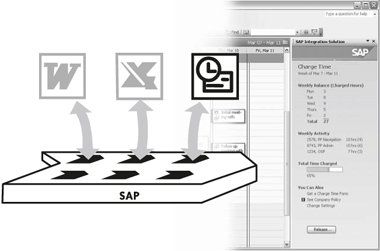Section 9.1. What is the goal of Project Mendocino?
9.1. What is the goal of Project Mendocino?The goal of Project Mendocino is to improve the way information workers interact with business processes by closing the gap between desktop productivity tools and enterprise business applications. The expected results are more efficiency and less inconsistency. Information workers will no longer have to switch between enterprise tools and desktop applications. The tools that information workers use today are unstructured and unlinked to backend processes. Now those tools are linked to underlying business processes so that transactions in the Enterprise Resources Planning (ERP) system can be triggered directly from the desktop, as shown in Figure 9-2. Figure 9-2. Exposing SAP tools through Microsoft Office As a result, less time will be wasted searching for such information as the amount of vacation time accrued or budget outlays. No one will have to enter the same data into two different systems, thus making it less likely that erroneous information is passed along. Automated processes mean that investments in best practices within the enterprise applications are utilized to the fullest. One result is that companies will be better able to comply with corporate and industry regulations. By dovetailing all of these capabilities into the simple UI of Microsoft Office, businesses can reduce reliance on power users and increase workplace efficiency. Project Mendocino delivers other significant benefits, including:
By exposing selected business process functions and data from mySAP ERP 2004 through Microsoft Office, Project Mendocino leverages the openness of Microsoft's .NET infrastructure with ESA. This enables information workers to perform corporate-driven tasks such as time management, budget monitoring, organization management, and leave management through their desktops, using features such as:
Microsoft and SAP will sell and support Project Mendocino. An early version of the product was available to select customers in December 2005. General availability is slated for the third quarter of 2006, when it will also receive its official product release name (Project Mendocino is a code name). |
EAN: 2147483647
Pages: 265